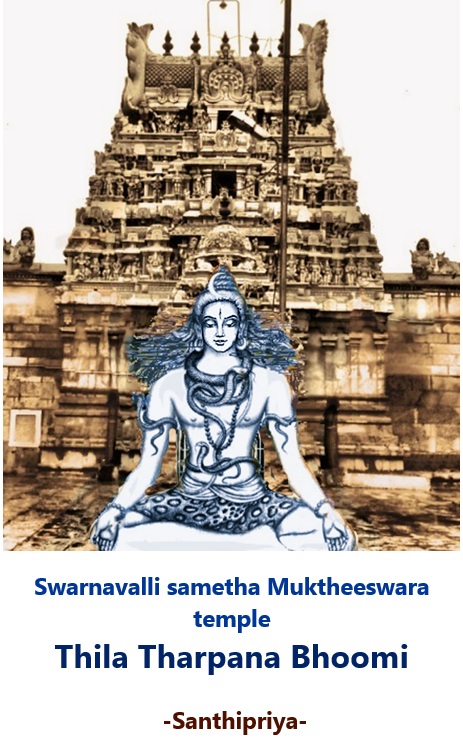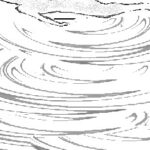
In the past, two rivers, namely, Hari and Shiva, a sub river of Ganges ran by the side of Muktheeswara temple in Thila Tharpana Bhoomi, few Kilometers away from Koothanoor in Tamilnadu, where popular temple for Goddess Saraswathi exists.
Sati, an incarnate of Goddess Parvathi committed suicide by jumping in the sacrificial fire giving up her body unable to bear her husband’s public humiliation by her father who performed a yagya and invited everyone except Lord Shiva; Sati’s husband was none but Lord Shiva. Though Sati killed herself while in human form, she was not given the final rites that are performed for the deceased. Driven by grief and rage after his wife Sati’s suicidal death, Lord Shiva carried her corpse over his shoulders and went across the universe in fit of rage, threatening cosmic balance.
Fearing it will cast disaster and to contain the anger of Lord Shiva, immediately Lord Vishnu engaged his divine weapon, the Sudarshana Chakra and sliced Parvathi’s lifeless body, into many pieces. The pieces of flesh fell to earth at various locations as Lord Shiva roamed. Every location where Sati’s flesh fell got elevated to sacred site and transformed into Sakthi Peeda by way of construction of temples much later.
Divines descend to earth for specific missions including to redeem their curses; after several years of penance, they leave their mortal coil to go back to their divine abodes once the purpose is accomplished. The mortal coils thus left by them got buried and over period of time turned into rock or stones in natural process inside the soil or the river in which they lay buried.
Purification rites are primary requirements for human beings to cleanse physical and spiritual impurities, prepare for worship or rituals, and to atone for sins allowing for spiritual elevation. Similar to the purification rites undertaken by the humans, when deities take on an earthly form and leave their mortal coil after completing their mission, divine specific purificatory acts or rituals are also needed to be done by them, before returning to their abode in devaloga, so say knowledgeable pundits.
Under one such circumstances, Goddess Parvathi who was then Sati, after committing suicide by jumping into the fire, came over to the then forested area of Thila Tharpana Bhoomi to sit in penance to cleanse her soul before returning to her abode in Himalayas. Incidentally after getting humiliated at the yagya site, Lord Shiva too came to Thila Tharpana Bhoomi, which was then called as Mantra Vanam (meaning forest reverberated with mantras chanted by sages and saints here and there) and sat in deep penance to purify self for having carried the corpse of his consort Sati after she committed suicide.
When Lord Shiva sat in penance, the powerful river Goddess Ganges, who is seated over his matted locks, released a tiny, gentle stream of her water to flow onto the ground. She did this to create a cooler atmosphere in the forest area which would be similar to Lord Shiva’s abode in the Himalayan forests; at the same time, she did not wish to disturb him by flowing fast. The gentle stream thus became Hari-Shiva River much later.
It is a widely held belief that offering Pind Daan (rice balls), performing Tarpan (offering water mixed with sesame seeds) or performing Srartha ceremony at Thila Tharpana Bhoomi is considered to be of equivalent spiritual merit to performing it in Kashi which help the departed soul attain moksha (liberation from the cycle of rebirth). The Tharpan is generally performed by pouring water mixed with sesame seeds into the rivers or some water bodies. At home when Tharpan is done, we pour the same on to the ground. There are seven sacred sites where the Srartha ceremony and Tharpan when performed, give salvation to the souls of the departed for whom they were done. Those sites are Kasi, Rameswaram, Srivanjiyam, Thiruvengadu, Thila tarpana bhoomi, Gaya and Allahabad.
Against this background when Goddess Parvathi, who was Sati then, came down to earth and reached the forested land of Thila Tharpan Bhoomi, she was mentally fatigued, anxious, unclear and nervous on how to rejoin with her consort as no cremation rites were performed to her body (corpse) which lay strewn in different places on the planet after Lord Vishnu cut her corpse to pieces to contain the anger of Lord Shiva. After analysing different perspectives, she realized that she had to first perform self Tharpan to purify herself and to get rid of the sins arising out of suicide so that her body parts will turn sacred unlike human body which will decay if left non cremated or buried.
The entire episodes- Goddess Sati, the incarnate of Goddess Parvathi committing suicide; Lord Shiva carried her corpse over his shoulder and performed aggressive tandava dance, the corpse of a Goddess sliced to pieces by another divine which fell in different areas of the planet to cause those areas turn sacred sites of Goddess Parvathi, the Sakthi devi and a divine ending their incarnation by committing suicide etc- were all unique in nature.
The one slightly similar act which happened in Ramayana, relates to Goddess Sita, an incarnate of Goddess Mahalakshmi, who jumped into fire to prove her modesty; it was not an attempt to commit suicide, but an act to prove her modesty though she was instantly absorbed by earth Goddess Bhooma Devi by creating a crater ensuring that Goddess Sita’s body did not burn down in fire; Goddess Sita vanished thereafter. Few other acts of divine disappearances were seen.
Lord Krishna struck by a hunter’s arrow fell dead, but his human body disappeared by itself; Lord Parasurama, Lord Ram, and Lord Lashman entered into the sea and disappeared; Goddess Renuka Devi, mother of Lord Parasurama disappeared while accompanying her slain husband who was taken for cremation by his son Lord Parasurama (Read Dattathreya Story); Adi Sankara, a divine incarnate of Lord Shiva disappeared in the Himalayas. None of their bodies were recovered or found anywhere, but all of them got back their divine form. However, in the case of Sati, her corpse was cut to pieces and thrown in different places in divine drama enacted. Therefore, it became imperative for Goddess Parvathi to perform self Tharpan to cleanse her soul and get freed of wordily attachments which was carried by her physical body.
Offering water mixed with sesame seeds to the soul of the deceased is called Tharpan. Since sesame seed has been reportedly originated from Lord Vishnu, it is capable of absorbing the chants and vibrations of the mantras and release invisible energy waves that not only quenches the thirst of the departed souls and Pithrus in Pithru Loga, but also purifies the invisible body of the soul of divines whenever needed. Hence, the sesame seed plays an important role in any of the Tharpan performed.
Therefore, Goddess Parvathi took bath in Hari-Shiva River, performed the unique self Tharpan sitting over the bed of sesame seeds spread over a piece of wet land, performed Tharpan to purify her soul and to re-absorb her divine energies floated in the cosmic realm, unattached to her soul. Even though Sati was incarnate of Goddess Parvathi, her soul needed purification because she had taken a human form and committed suicide. Since Sati, incarnate of Goddess Parvathi, sat over the bed of sesame seed and performed self Tharpan, the place came to be called as Thil (sesame seeds)+ Tharpan (pouring sesame seeds mixed with water into some water body or wet land as offering to the demised souls) + Bhoomi(land) = Thila Tharpana Bhoomi.
In similar manner after rescuing Goddess Sita from the captivity of Ravan by waging war in Lanka, both Lord Rama and Lord Lakshman came to Thila Tharpan Bhoomi to offer Pinda Dhan and perform Srartha ceremony to their late father King Dasarath and father-like figure divine bird Jadayu to get rid of the Brahmahatti Dosha attracted by them for having killed many of the brahmin soldiers of King Ravan.
There lies a background story which compelled them to come to Thila Tharpana Bhoomi. Even though both performed Srartha ceremony to their demised father while in exile in the forest, they were not mentally satisfied, nor did they derive peace of mind since not one of the crows came and eaten the rice balls offered as Pinda Dhan in Srartha ceremony performed by them. It is a traditional belief that if the Pinda balls are not eaten by crows as offered during the Shrartha ceremony, either the Pithrus (ancestors) were not satisfied or the ritual was incomplete. Therefore, when they approached their mentor Maharishi Vashistha seeking advice, he shared a unique story as told to him by Maharishi Narad Muni.
Once, when Narad Muni happened to pass through the jungle of Thila Tharpan Bhoomi , he saw a river flowing in the name of Hari-Shiva. When he contacted Goddess Ganga to know the origin of Hari-Shiva, she revealed that it was released by her to cool the atmosphere to to give comfort to Lord Shiva who was in penance there in invisible form. In a few days she was surprised to find that some of the Pithrus from yama loga descended at the bank of Hari-Shiva in the form of crows and accepted the Pinda offered by the people who performed Srartha ceremony and went away to heaven instead of returning back to Yama Loga. When the Pithrus came over there, nowhere presence of Yama ganas were seen. She also happened to notice Lord Brahma sitting in invisible form near Koothanoor where Goddess Saraswathi temple existed took note of the Pithrus in silence without disturbing the penance of Lord Shiva. Unable to get an answer to the mysterious acts, Goddess Ganga requested Narada Muni to find out and tell her the rationale behind the absence of the Yama ganas under whose custody the Pithrus remained, but came there to accept the Pind Dhan and went to heaven instead of Yama Loga. When Narad Muni heard of the thrilling news from Goddess Ganga, he waited there till Lord Shiva’s penance ended to know answers to those mysterious acts.
Once Lord Shiva ended his penance, he clarified to Narad Muni that Yama Ganas can not enter the place where he sat in penance; hence in Thila Tharpan Bhoomi they dare not accompany the Pithrus who came to partake the Pind in Thila Tharpana Bhoomi without straying elsewhere, lest, the yama ganas can catch them outside the periphery of Thila Tharpan Bhoomi and torture them in torture cells in yama loga. Once the Pithrus partook Pind there, Lord Shiva gave them salvation by ending all their karmas and therefore the Pithrus were allowed to go to heaven from there.
Since both Lord Moon and Lord Sun together visited Thila Tharpan Bhoomi everyday to offer prayers to Lord Shiva who was seated there as Muktheeswara- meaning the one who gives salvation- every day is considered as amavasya in Thila Tharpan Bhoomi and therefore round the year anyone can come any time convenient to them and perform Srartha ceremony to their ancestors/ relatives/friends.
The rituals performed in Thila Tharpana Bhoomi was considered potent enough to alleviate the ancestors’ Pitru Dosha and resolve unfulfilled karmas, which facilitated them to bypass Yama Loka and proceed directly to higher realms or heaven.
When both Rama and Lakshman heard the story from Maharishi Vashisht they wasted no time and went to Thila Tharpan Bhoomi to perform Srartha ceremony to Dasaratha and father like Jadayu and derived mental peace thereafter. When they offered Pind to the departed souls, the Pind -rice balls- kept by them instantly turned into four Shiv Lingas. Both King Dasaratha and Jadayu appeared before Rama and Lakshmana and informed that they were going back fully satisfied.
After several years once when Narad Muni visited the Kingdom, ruled by another pious King, he told the same stories to him to persuade him to generously spend money to develop the then Thila Tharpan Bhoomi.
Even today the four shiva lings worshipped by Rama and Lakshmana can be seen on the back side of the main sanctum of Muktheeswara- Swarna Valli, however the river Hari-Shiva is not to be seen. The newer river Hari-Shiva, emerged from the Ganges, went underground on the same location and became invisible after Lord Shiva’s penance ended. Later, it is believed to have reemerged, altered its position and flowed in the name of the Arasalur river, a short distance away from Thila Tharpana Bhoomi. The story that Hari-Shiva River’s disappearance into the earth to re-emerge as the Arasalur river is a specific local legend based on mythological belief.
The main deity is Lord Shiva is seated in the name of Muktheeswara (Shiva Ling) who absolves all their sins of the Pithrus who visit there to accept the Pinda and give them salvation. Muktheeswara is accompanied by his consort in the name of Swarna Valli.
Lord Vinayaga with human head in Thila Tharpana Bhoomi

Thila Tharpana Bhoomi is renowned for its Adi Vinayaga shrine, where Lord Vinayaga is seen depicted with a human face. This is a highly unique aspect, as in no other temples of Lord Vinayaga, he can be seen with human head but features only an elephant head.
After committing suicide, Goddess Sati, incarnate of Goddess Parvathi came to Thila Tharpan Bhoomi which was then a thick forested area to cleanse her soul to get back her original divine form. As explained earlier Lord Shiva too was there in penance inside the forest area and both were not aware of each others stay. Daily Goddess Parvati took bath in nearby river before commencing the self Tharpan for self. In order to guard the entrance of her bathe room and to prevent anyone from entering while she was taking bath, she converted her son Vinayaga into a small boy, asked him to hid inside a small ball made out of Turmeric powder and stand guard at the entry point in invisible form. Lord Vinayaga sat at the entrance facing northern direction.
Lord Shiva after ending his penance went back. Finding his consort missing at home, he began to search for her all over the planet and came back to Thila Tharpan Bhoomi, on hearing that she was performing self Tharpan to cleanse her soul. When he tried to enter the bath area where she was taking bath, Lord Vinayaga in the form of an unknown young boy stopped him from entering.
Enraged Lord Shiva beheaded the young boy without knowing that whom he beheaded was his own son Vinayaga. Goddess Parvati when heard the commotion, she quickly dressed up and came running; saw beheaded son, broke down in tears and revealed who the boy whom Lord Shiva beheaded was and pleaded with Lord Shiva to get back her son in his full form
Realizing his mistake Lord Shiva immediately sent out his ganas to bring the head of anyone seen sleeping with his head pointing towards north. While searching the shiva ganas discovered an elephant sleeping facing northern direction and returned with its head. Shiva then resurrected the young boy by affixing the elephant’s head to his body. Thus, Lord Vinayaga lost his human head and had to remain with an Elephant head. The parents embraced him and blessed him. They declared that from then on, Lord Vinayaka would appear with a human head only in Thila Tharpana Bhoomi and bless the devotees, while they will be seated in the temple opposite to the shrine of Lord Vinayaga to grant salvation to the Pithrus for whom Tharpan will be done in Thila Tharpana Bhoomi.
They further proclaimed that unless the visitor first offered worship to Lord Vinayaga with human head seated in the opposite shrine, they will not get the blessings from either Muktheeswara or Swarna Valli. Thus, the place where Adi Vinayaga appeared with a human face in the south became an incomparably superior temple land thereafter.




